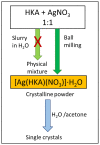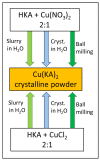Exploring the Co-Crystallization of Kojic Acid with Silver(I), Copper(II), Zinc(II), and Gallium(III) for Potential Antibacterial Applications
- PMID: 36770910
- PMCID: PMC9920434
- DOI: 10.3390/molecules28031244
Exploring the Co-Crystallization of Kojic Acid with Silver(I), Copper(II), Zinc(II), and Gallium(III) for Potential Antibacterial Applications
Abstract
Co-crystallization of kojic acid (HKA) with silver(I), copper(II), zinc(II), or gallium(III) salts yielded three 1D coordination polymers and one 0D complex in which kojic acid was present as a neutral or anionic terminal or bridging ligand. All reactions were conducted mechanochemically via ball milling and manual grinding, or via slurry. All solids were fully characterized via single-crystal and/or powder X-ray diffraction. As kojic acid is a mild antimicrobial compound that is widely used in cosmetics, and the metal cations possess antibacterial properties, their combinations were tested for potential antibacterial applications. The minimal inhibition concentrations (MICs) and minimal biocidal concentrations (MBCs) for all compounds were measured against standard strains of the bacteria P. aeruginosa, S. aureus, and E. coli. All compounds exerted appreciable antimicrobial activity in the order of silver, zinc, copper, and gallium complexes.
Keywords: antimicrobial metals; antimicrobials; co-crystallization; copper; gallium; mechanochemistry; silver; zinc.
Conflict of interest statement
The authors declare no conflict of interest.
Figures











Similar articles
-
Comparison of Antimicrobial and Antibiofilm Activity of Proflavine Co-crystallized with Silver, Copper, Zinc, and Gallium Salts.ACS Appl Bio Mater. 2022 Sep 19;5(9):4203-4212. doi: 10.1021/acsabm.2c00404. Epub 2022 Aug 15. ACS Appl Bio Mater. 2022. PMID: 35970511 Free PMC article.
-
Mechanochemical Preparation, Solid-State Characterization, and Antimicrobial Performance of Copper and Silver Nitrate Coordination Polymers with L- and DL-Arginine and Histidine.Int J Mol Sci. 2023 Mar 8;24(6):5180. doi: 10.3390/ijms24065180. Int J Mol Sci. 2023. PMID: 36982258 Free PMC article.
-
Zinc(II), copper(II) and silver(I) salicylate-metronidazole complexes as novel antimicrobial agents.Dalton Trans. 2025 Aug 5;54(31):11925-11934. doi: 10.1039/d5dt01086a. Dalton Trans. 2025. PMID: 40685700
-
Chirality in metal-based antimicrobial agents: a growing frontier in biomedical research.Dalton Trans. 2025 Apr 28;54(17):6778-6784. doi: 10.1039/d5dt00400d. Dalton Trans. 2025. PMID: 40223776 Review.
-
Gallium Liquid Metal: Nanotoolbox for Antimicrobial Applications.ACS Nano. 2023 Aug 8;17(15):14406-14423. doi: 10.1021/acsnano.3c06486. Epub 2023 Jul 28. ACS Nano. 2023. PMID: 37506260 Review.
Cited by
-
Synergistic Antimicrobial Effects of Melaleuca alternifolia Essential Oil and Kojic Acid Combinations.Curr Microbiol. 2025 Mar 13;82(5):192. doi: 10.1007/s00284-025-04175-4. Curr Microbiol. 2025. PMID: 40080195
-
From 0D-complex to 3D-MOF: changing the antimicrobial activity of zinc(II) via reaction with aminocinnamic acids.Front Chem. 2024 Jul 8;12:1430457. doi: 10.3389/fchem.2024.1430457. eCollection 2024. Front Chem. 2024. PMID: 39040090 Free PMC article.
-
Searching for Suitable Kojic Acid Coformers: From Cocrystals and Salt to Eutectics.Cryst Growth Des. 2023 Feb 9;23(3):1874-1887. doi: 10.1021/acs.cgd.2c01364. eCollection 2023 Mar 1. Cryst Growth Des. 2023. PMID: 36879772 Free PMC article.
References
-
- 2019 Antibacterial Agents in Clinical Development: An Analysis of the Antibacterial Clinical Development Pipeline. World Health Organization; Geneva, Switzerland: 2019.
MeSH terms
Substances
Grants and funding
LinkOut - more resources
Full Text Sources
Research Materials

